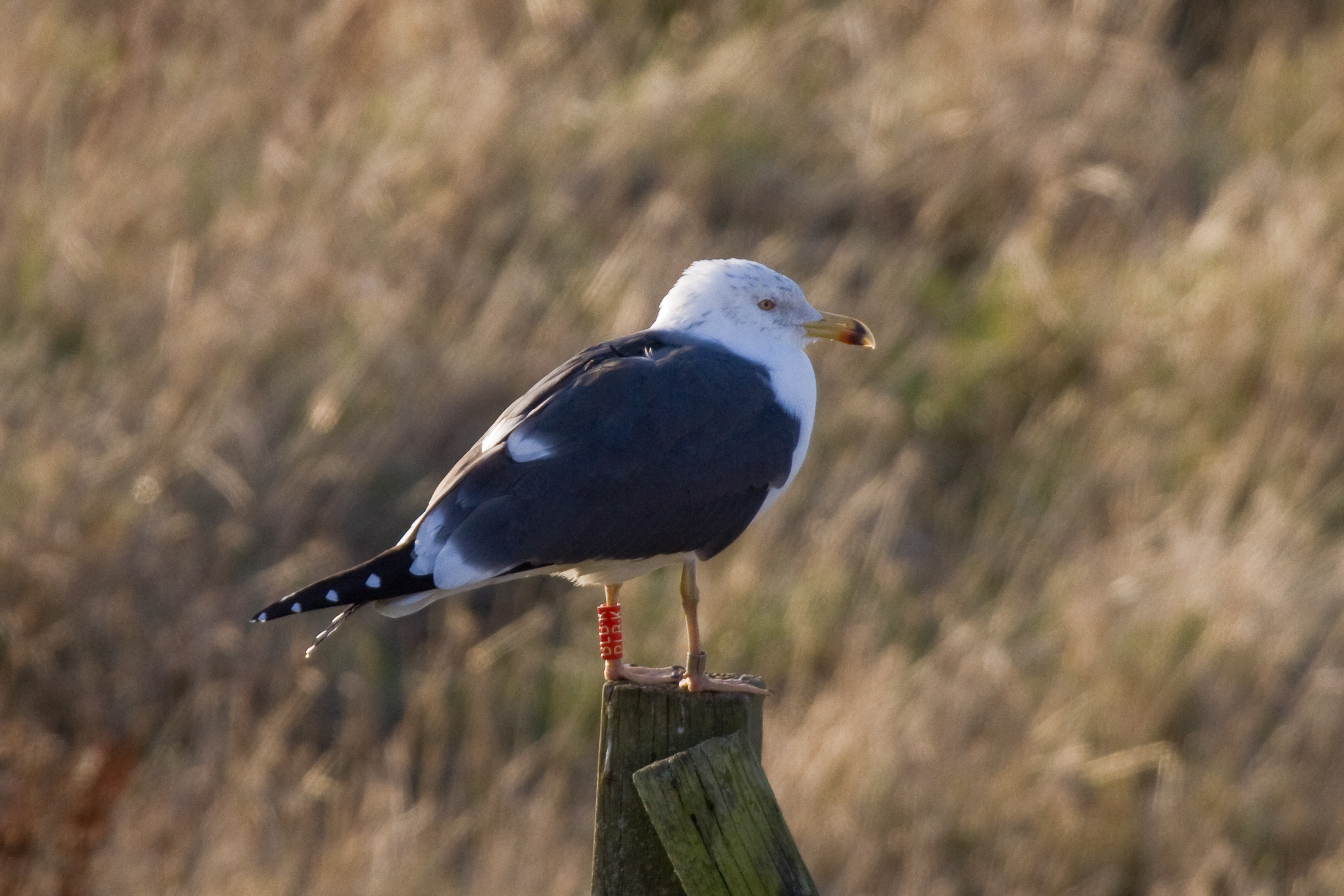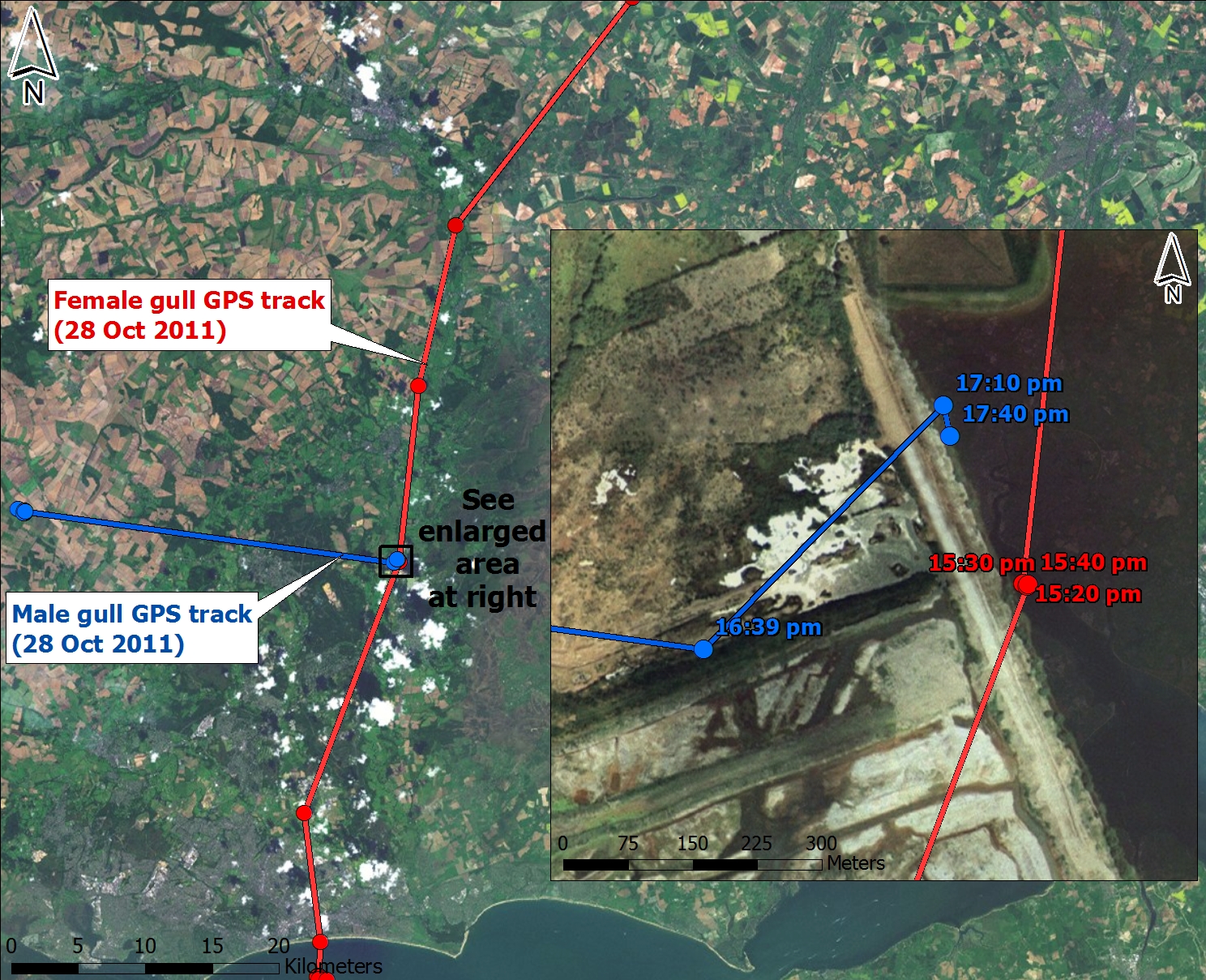Tagged Lesser Black-backed Gulls return to Orford Ness
Wednesday, April 18th, 2012
Species: Lesser Black-backed Gull
Project: Seabird-wind farm interactions - Orford Ness
On 20th February we received an exciting email from one of our volunteer gull ringers at Orford Ness – our first GPS-tagged Lesser Black-backed Gull of the year had returned to breed! Since then other gulls have come to join it, and fifteen tagged birds are now back (twelve tagged in 2011 and three from 2010). Last year all our tagged gulls migrated to wintering grounds in Iberia and North Africa. This year, we’ve seen some very different movements, with some birds going to Morocco, Spain and Portugal, but others staying in the UK for the whole winter – one individual did not even leave East Anglia!
These contrasting patterns are beautifully illustrated by our only tagged breeding pair of gulls, which were both fitted with GPS transmitters on 21st May 2011. The male in this pair spent most of his winter in Dorset, Hampshire and Somerset, primarily roosting in and around Poole Harbour on the south coast of England. His mate, meanwhile, opted to sun herself in Lisbon, Portugal. Intriguingly, these birds, that left Orford Ness in late summer, nearly met in late October, when the female was preparing to depart for warmer climes. On the afternoon of 28th, the female called in on Ibsley Water in Hampshire for about half an hour. Less than an hour later, the male was also there, having returned to roost after spending the afternoon on fields near Blandford Forum. However, our female had already left and was on her way south, missing a reunion with her mate by a matter of minutes!
Interestingly, none of the birds that stayed in the UK was tagged in 2010. All birds for which we now have two years’ worth of data took very similar routes and chose almost the same wintering destinations as they did during last winter. They therefore all ended up in Spain, Portugal and Morocco again. However, the timings were slightly different this year, with birds returning to the colony earlier than they did last spring. It is interesting to speculate about the reasons underpinning our gulls’ diverse migratory strategies. We hope our questions will be answered as more birds return, both to Orford Ness and Texel.
More information on this project can be found at:
http://www.bto.org/science/migration/tracking-studies/tracking-lesser-black-backed-gulls/march-2012-update.
Latest Highlights

Overwintering and foraging areas used by a 24-year old Eurasian spoonbill
Wednesday, April 18th, 2018

Lesser Black-backed Gulls from Schiermonnikoog enjoy their winter holiday
Tuesday, April 3rd, 2018

Oystercatchers returning from inland breeding grounds
Sunday, July 23rd, 2017

GPS tracker with SMS messaging
Monday, November 2nd, 2015

Ronny found back, three years after deployment of the UvA-BiTS GPS-tracker
Wednesday, July 8th, 2015

Lesser Black-backed Gulls feed on potato crisps in Moeskroen
Wednesday, November 13th, 2013

‘Vogel het uit!’ has won the 2013 Academic Year Prize
Tuesday, November 5th, 2013

Back in Europe: UvA-BiTS Honey Buzzard photographed at the Strait of Gibraltar
Wednesday, May 15th, 2013

UvA-BiTS database passes 10 million record mark
Wednesday, May 8th, 2013

Gulls pouring into the Kelderhuispolder colony
Wednesday, April 17th, 2013

To the Karoo and back: Mate replacement & GPS tracking study of an ousted eagle
Monday, March 25th, 2013

Meeting Montagu’s Harrier Edwin in Senegal
Wednesday, March 20th, 2013

Oystercatchers: Learning how and where to survive
Wednesday, August 29th, 2012

New GPS mini-tracker facilitates investigation into movement of smaller animals
Wednesday, July 4th, 2012

Over 5 million GPS fixes in the UvA-BiTS database
Thursday, June 21st, 2012

Tagged Lesser Black-backed Gulls return to Orford Ness
Wednesday, April 18th, 2012

Gulls spotted in their over-wintering areas
Wednesday, December 21st, 2011

The UK a top vacation destination in 2011
Wednesday, July 13th, 2011

A long way from home
Sunday, June 26th, 2011

Visiting Amsterdam for a day
Saturday, May 14th, 2011

Female deserts brood, male raises chicks
Friday, May 13th, 2011

Wintering range in Sierra Leone
Friday, May 13th, 2011

Camera watches foraging Oystercatchers day and night
Thursday, May 12th, 2011

The return of a bird presumed dead
Wednesday, May 11th, 2011

Texel gulls back from wintering areas
Sunday, May 1st, 2011

First Lesser Black-backed Gull returns to the breeding colony
Monday, April 13th, 2009



